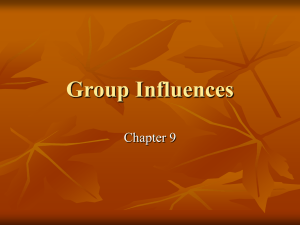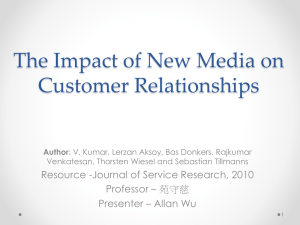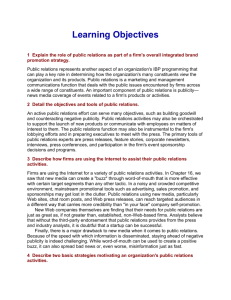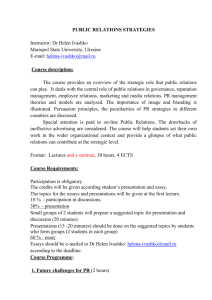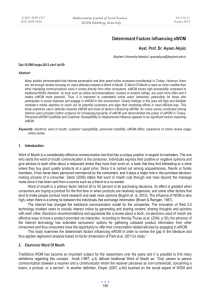Location, Location, Location: The Relative Roles of Virtual Location
advertisement
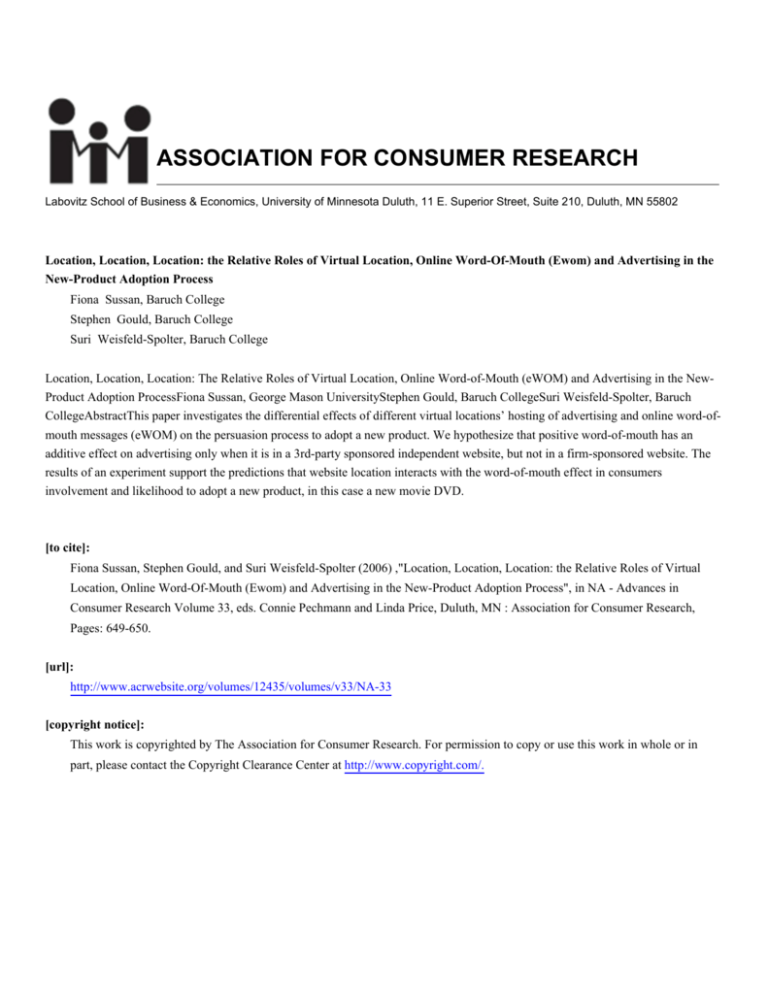
ASSOCIATION FOR CONSUMER RESEARCH Labovitz School of Business & Economics, University of Minnesota Duluth, 11 E. Superior Street, Suite 210, Duluth, MN 55802 Location, Location, Location: the Relative Roles of Virtual Location, Online Word-Of-Mouth (Ewom) and Advertising in the New-Product Adoption Process Fiona Sussan, Baruch College Stephen Gould, Baruch College Suri Weisfeld-Spolter, Baruch College Location, Location, Location: The Relative Roles of Virtual Location, Online Word-of-Mouth (eWOM) and Advertising in the NewProduct Adoption ProcessFiona Sussan, George Mason UniversityStephen Gould, Baruch CollegeSuri Weisfeld-Spolter, Baruch CollegeAbstractThis paper investigates the differential effects of different virtual locations’ hosting of advertising and online word-ofmouth messages (eWOM) on the persuasion process to adopt a new product. We hypothesize that positive word-of-mouth has an additive effect on advertising only when it is in a 3rd-party sponsored independent website, but not in a firm-sponsored website. The results of an experiment support the predictions that website location interacts with the word-of-mouth effect in consumers involvement and likelihood to adopt a new product, in this case a new movie DVD. [to cite]: Fiona Sussan, Stephen Gould, and Suri Weisfeld-Spolter (2006) ,"Location, Location, Location: the Relative Roles of Virtual Location, Online Word-Of-Mouth (Ewom) and Advertising in the New-Product Adoption Process", in NA - Advances in Consumer Research Volume 33, eds. Connie Pechmann and Linda Price, Duluth, MN : Association for Consumer Research, Pages: 649-650. [url]: http://www.acrwebsite.org/volumes/12435/volumes/v33/NA-33 [copyright notice]: This work is copyrighted by The Association for Consumer Research. For permission to copy or use this work in whole or in part, please contact the Copyright Clearance Center at http://www.copyright.com/. Location, Location, Location: The Relative Roles of Virtual Location, Online Word-of-Mouth (eWOM) and Advertising in the New-Product Adoption Process Fiona Sussan, George Mason University Stephen Gould, Baruch College Suri Weisfeld-Spolter, Baruch College EXTENDED ABSTRACT It is no secret that the emergence of cyberspace has changed marketing communications (Rogers and Allbritton 1995; Silk et al. 2001). More prominently, the Internet has changed from face-toface social based interpersonal communications to one of computer-based social networking (Wellman 2001). Cyberspace allows consumers to “gather” in virtual communities and exchange opinions that lead to an “information democracy” in which the information is tilted toward the consumer instead of being manipulated by marketers (Armstrong and Hagel 1993; Bargh and McKenna 2004; Rheingold 1993l; Sawhney and Kotler 2001). In other words, cyberspace allows the opportunity for the voices of consumers to possibly drown that of the marketers. In spite of the advocacy and the reality of the proliferation of online word-of-mouth, (eWOM) with 33% of all adult Americans having participated in it in one way or another (www.pewinternet.org), researchers mainly remain silent about this phenomenon in relation to advertising within the new-product adoption process. Traditionally, marketing and interpersonal communications were separated by time and place with mass media transmission first, followed by word-of-mouth interpersonal communications through face-to-face social contacts (Two-Step Flow by Katz and Lazarsfeld 1955; New-product Diffusion Process by Rogers 1962). The quality of the Internet merging both mass media and interpersonal communications into one changed that (Deighton 1997). Consumers can now access both marketing and interpersonal communications at the same time and at the same space on multiple websites. The question then becomes, how does this new combination affect the persuasion process within new-product adoption? Are the combined advertising and word-of-mouth messages effective in all websites? Previous persuasion research has elicited that when there is an incongruity between the source (the messenger) and the message (content) in advertising, the persuasion effect could be negative instead of positive as originally intended (Slater and Rouner 1996). In this paper, we argue further that even when the source and message are congruous, their incongruity with the location could lead to a lesser or even an opposite persuasion effect than intended. In other words, this paper speculates that when a firm includes positive eWOM in its own website to facilitate its marketing communication messages, similar to that of mass-media based advertising using “fellow consumers” word-of-mouth endorsement, the persuasive effectiveness may diminish. This is because consumers would most likely perceive the positive eWOM as a deliberate part of manipulated marketing communications, a phenomenon especially not welcome under the Internet-based new “information democracy” previously mentioned (Sawhney and Kotler 2001). This paper extends this argument to suggest that the inclusion of positive eWOM in a firm’s website may in fact undermine the firm’s own marketing messages. In order to make eWOM a part of an effective persuasive communication within the new-product adoption process, we suggest allocating it within a 3rd-party independent website that has no affiliation with the advertising firm. While the independency of the source enabling a more persuasive effect is not new, in this paper we are extending the independency requirement to the “location” which hosts both the source and the message. We hypothesize that the independency of the location will maximize the persuasive effectiveness of the message. Further, we hypothesize that simply advertising on a 3rd-party independent website would not necessarily increase its persuasive effectiveness when compared to that of the firms’ own websites. This is due to the fact that persuasion knowledge model posits that consumers can detect advertising messages and can identify an agent trying to influence them and will activate their persuasion knowledge accordingly. In this sense, consumers do not vary their attitudes toward the advertising message in either website. This paper aims to measure the perceived persuasiveness of the combination of advertising and word-of-mouth communications in two types of websites (firm-sponsored versus 3rd-party independent-sponsored websites) toward the new product adoption process to include consumers’ interest and likelihood to adopt a new product. A fictitious movie with its advertising and word-of-mouth information were given to four groups of subjects to measure their response on website location effect, word-of-mouth effect and quantitative information effect. A 2 (firm-sponsored vs. 3rd-party sponsored independent website) x 2 (advertisement only vs. advertisement plus eWOM) between-subject design was used in this experiment. The product used was a new movie DVD. The independent variables consisted of website location and eWOM. Involvement and likelihood to adopt a new product were the two dependent variables. A total of ninety subjects were recruited from a participation pool at a large Northeastern university. The subjects received course credit for participation. All subjects were assigned randomly to the treatment conditions. After conducting an ANOVA, we found empirical support for positive online word-of-mouth having an additive effect to advertising in 3rd-party sponsored websites but not in firm-sponsored websites. The results also supported the interaction effect between website location and eWOM messages, with eWOM added to advertising in a 3rd-party website having a larger additive effect on consumers involvement and likelihood to adopt a new product than in a firm-sponsored website. The results also supported the hypothesis that consumers do not differ in their involvement or likelihood to adopt a new product when exposed to only the advertisement, regardless of where it is placed. In particular, the findings of this study bring forth new evidence that positive word-of-mouth does not have an additive effect on advertising when they are placed within the company’s own website. This new evidence adds empirical support to the body of literature that has prophesized that the new virtual space will change the landscape of marketing and interpersonal communications to become a hybrid of mass interpersonal communications that empowers the consumer (Deighton 1997; Sawhney and Kotler 2001). Finally, this paper makes three important contributions. It adds knowledge to current literature in (1) website strategic management in deciding where not to include word-of-mouth communications, (2) word-of-mouth communications in the interaction effect of word-of-mouth and advertising in the online environment, 649 Advances in Consumer Research Volume 33, © 2006 650 / Location, Location, Location and (3) new-product adoption in shedding light as to why not all positive word-of-mouth communications are effective. REFERENCES Alba, Joseph, John Lynch, Barton Weitz, Chris Janiszewski, Richard Lutz, Alan Sawyer, and Stacy Wood (1997), “Interactive Home Shopping: Consumer, Retailer, and Manufacturer Incentives to Participate in Electronic Marketplaces,” Journal of Marketing, 61(July), 38-53. Armstrong, A.J. and J. Hagel III (1996), “The Real Value of OnLine Communities,” Harvard Business Review, (May-June), 134-141. Bargh, J.A. and K. McKenna (2004). “The Internet and Social Life,” Annual Review of Psychology, 55, 573-590. Bickart, Barbara and Robert M. Schindler (2001), “Internet Forums as Influential Sources of Consumer Information,” Journal of Interactive Marketing, 15, 31-40. Chaiken, Shelly and Durairaj Maheswaran (1994), “Heuristic Processing Can Bias Systematic Processing: Effects of Source Credibility, Argument Ambiguity, and Task Importance on Attitude Judgment,” Journal of Personality and Social Psychology, 66 (3), 460-473. Deighton, John (1996), “The Future of Interactive Marketing,” Harvard Business Review, (Nov-Dec), 151-162. Dellarocas, C. (2003), “The Digitalization of word of mouth: Promise and challenges of online feedback mechanisms,” Management Science, 49(10), 1407-24. Friestad, Marian and Peter Wright (1994), “The Persuasion Knowledge Model: How People Cope with Persuasion Attempts,” Journal of Consumer Research, 21 (June), 1-31. Guernsey, L. (2000), “Suddenly, everybody’s an expert on everything,” The New York Times, February 3. Harris, K., S. Baron, and B. Davies (1999), “What Sort of Soil do Rhododendrons Like?–Comparing Customer and Employee Responses to Requests for Product-Related Information.” The Journal of Services Marketing, 13(1), 2137. Jain K. and Srinivasan N. (1990), “An Empirical Assessment of Multiple Operationalisations of Involvement, In M.E. Goldberg and R.W. Pollay (Eds.), Advances in Consumer Research, 17, 594-602. Katz, E., & Lazersfeld, P. (1955), Personal influence: The part played by people in the flow of mass communications, Glencoe, IL: The Free Press. Kiecker, P. and D. Cowles (2001), “Interpersonal Communication and Personal Influence on the Internet: A Framework for Examining Online Word-of-Mouth,” Journal of Euromarketing, 11(2), 71-88. Rheingold, H. (1993), The Virtual Community, Reading, MA. Addison-Wesley. Rogers, Everett, M. and Marcel M. Allbritton (1995), “Interactive Communication Technologies in Business Organizations,” The Journal of Business Communication, 32 (2), 177195. Sawhney, M.S. and P. Kotler (2001), “The Age of Information Democracy,” D. Iacobucci (Ed.) Kellogg on Marketing, (pp.386-408). New York: John Wiley and Sons. Shah, Dhavan V., Jack M. McLeod, and So-Hyang Yoon, 2001, “Communication, Context, and Community: An Exploration of Print, Broadcast, and Internet Influences,” Communication Research, 28(4), 464-506. Slater, M.D. and D. Rouner (1996), “How Message Evaluation and Source Attributes May Influence Credibility Assessment and Belief Change,” Journalism and Mass Communication Quarterly, 73, 974-991. Silk, Alvin J., Lisa R. Klein, and Ernst R. Berndt, 2001, “The Emerging Position of the Internet as an Advertising Medium,” Netnomics: Economic Research and Electronic Networking, 3 (2), 129-148. Senecal, Sylvain, and Jacques Nantel, (2004), “The Influence of Online Product Recommendations on Consumers’ Online Choices,” Journal of Retailing, 80, 159-169. Suitor, Jill, Karl Pillemer, and Shirley Keeton (1995), “When Experience Counts: The Effects of Experiential and Structural Similarity on Patterns of Support and Interpersonal Stress,” Social Forces, 73(4): 1573-1588. Walthen, C. Nadine and Jacquelyn Burkell (2002), “Believe it or Not: Factors Influencing Credibility on the Web,” Journal of the American Society for Information Science and Technology, 53(2), 134-144. Wellman, B. (2001), “Physical Place and Cyberplace: The Rise of Personalized Networking,” International Journal of Urban and Regional Research, 25(2), 227-252. Zaichkowsky, Judith L. (1985), “Measuring the Involvement Construct,” Journal of Consumer Research, 12(December), 341-352
